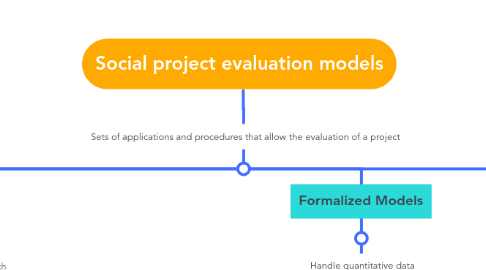
1. Sets of applications and procedures that allow the evaluation of a project
1.1. Analytical Models
1.1.1. Study observable and measurable phenomena
1.1.1.1. To obtain quantitative information and provide explanations about the project’s functioning.
1.1.1.1.1. Cost-Effectiveness Model
1.1.1.1.2. Cost-Benefit Model
1.2. Global Models
1.2.1. Use qualitative information within a holistic approach
1.2.1.1. To establish the meaning of the actions and activities developed within the project
1.2.1.1.1. CIPP Model
1.2.1.1.2. Focused Utilization Model
1.2.1.1.3. Expert Evaluation Model
1.2.1.1.4. Illuminative Evaluation Model
1.3. Formalized Models
1.3.1. Handle quantitative data
1.3.1.1. To obtain more verifiable data
1.3.1.1.1. Experimental Model
1.3.1.1.2. Quasi-Experimental Model
1.3.1.1.3. Regression Model
1.4. Semi-Formalized Models
1.4.1. Describe the secular trends of a project
1.4.1.1. To compare them with traditional behaviors of the dependent variables targeted by the programmatic intervention
1.4.1.1.1. Non-Experimental Before-and-After Model
1.4.1.1.2. After Model with Comparison Group
1.4.1.1.3. After Model
